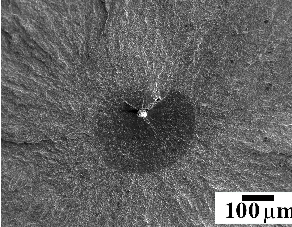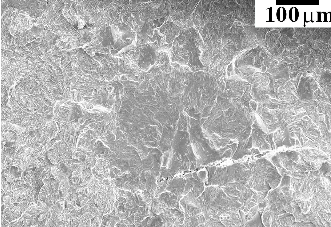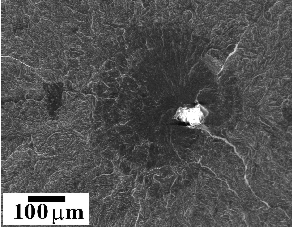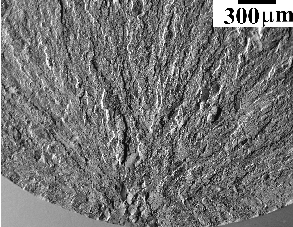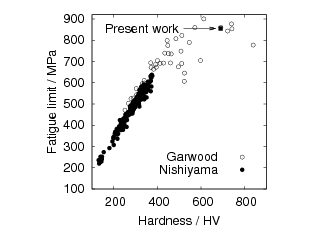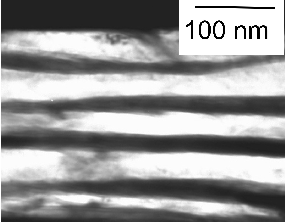
There is a novel steel invented in which the structure consists of extremely fine platelets of bainitic ferrite dispersed in a matrix of carbon–enriched retained austenite. The resulting large density of interfaces makes the alloy very strong in its transformed condition. We report the first fatigue tests on this system, by measuring the life of parallel gauged samples tested using cyclic loading in tension, with maximum stresses in the range 1.2–1.6 GPa. A comparison of the results against published data indicates that the performance of the steel is consistent with the behaviour of other strong steels, in spite of the fact that it is produced using an air–melting technique.
It is now possible to routinely and cheaply generate a very high density of interfaces in steel, resulting in strength which can be controlled in the range 1.6–2.5 GPa with a hardness of about 650–700 HV depending on the transformation conditions. The structure, which is obtained by the solid–state transformation of austenite at low homologous temperatures (180–250∘C), consists of plates of bainitic ferrite which are just 20–40 nm in thickness, dispersed in a residue of carbon–enriched retained austenite, Fig. 1 [1, 2].
There is an interest in developing these steels for the manufacture of shafts which have a high surface integrity, but which are subjected during rotation to alternating stresses, making the fatigue performance of the material an important design parameter. The purpose of the present work was to determine for the first time, the fatigue behaviour of a nanostructured steel.

There are many variants of the alloy system that have been shown capable of producing the bainite described above; the one which is the focus of the present work contains a modest addition of cobalt in order to accelerate the transformation, since cobalt increases the free energy difference between austenite and ferrite [3, 4]. The material used was produced as a 25 kg experimental air–melt supplied by Corus, rolled to approximately 45 mm thick plate. A block 40×50×100 mm was homogenised in a vacuum furnace at 1200∘C for two days, followed by furnace cooling to room temperature. The chemical composition of the alloy is

 . In separate work [7] where the transformation period at 200∘
C was
three days, the 0.2% proof strength achieved was 1.19 GPa, an ultimate tensile strength of 2.18 GPa, and
elongation of 4.6 %.
. In separate work [7] where the transformation period at 200∘
C was
three days, the 0.2% proof strength achieved was 1.19 GPa, an ultimate tensile strength of 2.18 GPa, and
elongation of 4.6 %.
Cylinders 10 mm in diameter, machined from the homogenised steel, were placed in a furnace at 500∘C; the furnace was purged with argon throughout the heat treatment. The temperature was then raised to 900∘C over a period of 30 min, held at that temperature for 15 min, after which the samples were transferred into an oven at 200∘C±0.1 for 10 days to generate the fine bainite with a hardness of 680±3 HV50. After heat treatment, the blanks were machined into push–pull type fatigue samples with the final dimensions: 4.5 mm diameter, 12 mm gauge length, and a 9 mm radius leading on to the grips which had 20 UNF threads. Such samples expose a greater volume of material to tensile stress than rotating–bend specimens, and hence are better able to discover the role of inclusions. The gauge length was polished to give a 0.25 μm finish. The gauge length was masked and the threads of the samples were shot–peened using glass beads in order to prevent failure in the specimen grips.
Fatigue testing was conducted on an Instron 8800 testing machine, controlled by Instron LCF v7.2 Fast Track2 software. The loading was at a 0.25 Hz, with each 4 s cycle consisting of four steps, each of 1 s duration: a hold at the minimum tensile stress, followed by a linear ramp to the maximum stress, hold at that stress and a ramp down to the minimum stress. This is often said to be a trapezoidal 1-1-1-1 s profile. The ratio of the minimum to maximum stress was maintained at R = 0.1.
Fig. 2 summarises the outcomes and compares against the previously reported tensile strength [5, 6]; the 0.2% proof strength and elongation were reported as 1.45 MPa and 4.6% respectively.
Fractography revealed that failure initiated from inclusions except for samples tested at the highest of stresses, where cracks apparently began from the polished surface. The origins of fracture can be seen in Figs 3 to 7, and the complete set of results is summarised in Table 1. The inclusions were identified using energy dispersive X–ray analysis as oxides, high in aluminium or magnesium; calcium sulphide was also observed.
Classic ‘white area’ or ‘fish eye’ fracture patterns characteristic of fatigue fracture [8] can be seen in samples tested at maximum stresses (σmax) of 1.3 and 1.4 GPa in Figs 3 and 6. For the samples tested at σmax =1.5 and 1.6 GPa, the fracture surfaces appeared much more brittle, making it very difficult to discern any area of fatigue crack growth.
The results are summarised as a S-N curve in Fig. 2. Regression analysis of the data, excluding the samples tested again at the greatest stress (i.e., excluding the filled circles in Fig. 2), permitted the estimation of the fatigue life as defined for our purposes to be the maximum cyclic stress for which the samples must survive 107cycles – this stress was found to be σmax =855 MPa which may represent a conservative estimate given that two of the samples survived 105 cycles at 1.2 and 1.3 GPa without failure.
A strong correlation has been observed between the fatigue limit and the hardness over a range of steels and microstructures [9, 10], Fig. 8. The linear trend in their results breaks down at high hardness values, with a maximum fatigue limit of 900 MPa at hardness of about 600 HV. The linear relation between the fatigue limit and hardness has also been shown for values below 400 HV, independent of microstructure or steel type [11]. This might be expected given that the resistance to plastic deformation, as measured by hardness indentations, determines also the resistance to the plasticity required to initiate and propagate fatigue [11]. Fatigue data analysed by Murakami [12] led to the proposal of a ‘defect–free fatigue limit’ σw0 which can be calculated from the tensile strength (σU) or the hardness (HV):
 | (1) |
This relationship has been shown to work well for hardness values below about 400 HV, independent of microstructure and even for aluminium alloys. However, L’vov et al. [13] studied a steel which contained metastable austenite and concluded that the microstructure did have an influence, both through the austenite substructure resulting from warm deformation during processing, and by transformation to martensite during loading. It is possible that both of these would be reflected in increased ultimate tensile strength and hardness.
Fig. 8 shows that the present steel, consisting of fine bainite and retained austenite, has a high fatigue limit which compares well with the other data [9, 10]. On the basis of equation 1, the present alloy should have a ‘defect free’ fatigue limit of σw0 = 1.1 GPa.
Given that the fatigue limit correlates with the hardness which is a coarse measure of properties, it is not possible from the present work to isolate the specific influence of retained austenite. Wenyan et al. [14] studied carbide–free bainitic steel samples containing retained austenite fractions 0.08 to 0.23, and found that the threshold stress-intensity increased and the crack propagation rate decreased, as the fraction of retained austenite was increased. This is in spite of the fact that the samples with less austenite were stronger. In general the opposite effect is expected since the crack growth increment per cycle should be inversely proportional to the cyclic yield strength because the crack tip opening displacement will be smaller when the yield strength is large. This reinforces the conclusion [14] that the austenite is beneficial to fatigue performance. Although the detailed mechanism is not understood, it is possible that the stress or strain–induced transformation of austenite is responsible for the improved properties [15]. On the other hand, a high strain hardening rate accompanying the transformation of austenite may be detrimental if this reduces the ability of the material to accommodate plastic strain [16, 17]. The role of austenite therefore deserves further study.
The level of cleanliness with respect to non–metallic inclusions has naturally been correlated against fatigue performance by many researchers. But the problem is difficult since the occurrence of infrequent and large inclusions depends also on the volume sampled by the stress. Inclusions in general may be regarded as stress concentrations through a variety of mechanisms including the loss of coherence with the matrix and when the particle itself fractures and introduces a sharp crack. The inclusion size, approximate shape and position within the sample are recorded in Table 1. It has been proposed [18, 19] that the fatigue limit σL is related to the hardness, and effective area of the inclusion as follows;
 | (2) |
where M is a constant depending on the position of a crack, non–metallic inclusion or defect, and is set equal to 1.43 for surface defects, 1.41 for sub–surface defects which touch the surface, and 1.56 for internal defects. The fatigue limit estimated in this way for each sample, based on the observed size of the inclusion, is appended to Table 1. There is some consistency in that the sample with the lowest life during testing with σmax = 1.4 GPa, also has the lowest calculated σL. Based on equation 2, the expected fatigue limit is 600–700 MPa depending on the inclusions sizes observed. Given that the fatigue limit obtained by extrapolating the data in Fig. 2 is 855 MPa, it is speculated that the steel is more tolerant to inclusions, possibly because of the presence of the retained austenite which would tend to relieve stress concentrations via transformation induced plasticity [20].
A nanostructured steel containing slender plates of bainitic ferrite in a matrix of high–carbon retained austenite has been studied under fatigue loading using tensile specimens in order to uniformly stress a significant volume of material. The tests were performed at high stresses whose maximum values were between 1.2–1.6 GPa. The performance of the steel is generally consistent with published work on iron alloys of similar hardness. A fatigue limit of about 855 MPa is estimated assuming no failure in 107 cycles, based on extrapolation of data in which the maximum number of cycles permitted was 105. Samples tested at lower loads survived 105 cycles which possibly makes the extrapolation a conservative estimate of the fatigue limit.
As is well known, the fatigue life depends upon the cleanliness of the steel, which in the present work was made as an air melt. It is assumed therefore that the fatigue performance of the nanostructured steel should be better when it is manufactured using clean steelmaking technologies.
The authors are grateful Rolls–Royce plc. for funding this research and to Professor Lindsay Greer for the provision of laboratory facilities at the University of Cambridge.
[1] F. G. Caballero, H. K. D. H. Bhadeshia, K. J. A. Mawella, D. G. Jones, and P. Brown. Very strong, low–temperature bainite. Materials Science and Technology, 18:279–284, 2002.
[2] F. G. Caballero and H. K. D. H. Bhadeshia. Very strong bainite. Current Opinion in Solid State and Materials Science, 8:251–257, 2004.
[3] H. I. Aaronson, H. A. Domian, and G. M. Pound. Partitioning of alloying elements between austenite and proeutectoid ferrite and bainite. TMS–AIME, 236:781–796, 1966.
[4] C. Garcia-Mateo, F. G. Caballero, and H. K. D. H. Bhadeshia. Acceleration of low–temperature bainite. ISIJ International, 43:1821–1825, 2003.
[5] C. Garcia-Mateo and F. G. Caballero. Role of retained austenite on tensile properties of steels with bainitic microstructures. Materials Transactions, 46:1839–1846, 2005.
[6] C. Garcia-Mateo, F. G. Caballero, and H. K. D. H. Bhadeshia. Mechanical properties of low–temperature bainite. Materials Science Forum, 500–501:495–502, 2005.
[7] M. Y. Sherif. Characterisation and development of nanostructured, ultrahigh strength, and ductile bainitic steels. University of Cambridge, 2005.
[8] P. H. Frith. Fatigue tests on rolled alloy steels mad in electric and open–hearth furnaces. J. Iron Steel Inst., 180:26–33, 1955.
[9] M. F. Garwood, H. H. Zurburg, and M. A. Erickson. Correlation of Laboratory Tests and Service Performance, chapter Interpretation of Tests and Correlation with Service, pages 1–77. ASM, 1951.
[10] S. Nishiyama. Statistical analysis of fatigue test data. Journal of the Society of Materials Science, Japan, 29:24–29, 1980.
[11] G. Chalant and B. M. Suyitno. Effects of microstructure on low and high cycle fatigue behaviour of a micro-alloyed steel. In M. Jono and T. Inoue, editors, Proceedings of the 6th International Conference on Mechical Behaviour of Materials, volume VI, pages 511–516, Kyoto, Japan, 1991. Pergamon Press, Oxford, Elsevier Science.
[12] Y. Murakami. Metal Fatigue: Effects of Small Defects and Nonmetallic Inclusions. Elsevier Science, Oxford, U. K., 2002.
[13] Yu. B. L’vov, A. Ya. Maloletnev, M. D. Perkas, Yu. G. Birakhovskii, N. K. Leonova, and Ya. B. Gurevich. Features of the fatigue failure of steel with metastable austenite. Metal Science and Heat Treatment, 22:868–870, 1980.
[14] L. Wenyan, Q. Jingxin, and S. Hesheng. Fatigue crack growth behaviour of a Si-Mn steel with carbide-free lathy bainite. Journal of Material Science, 32:427–430, 1997.
[15] G. R. Chanani, S. D. Antolovich, and W. W. Gerberich. Fatigue crack propagation in TRIP steels. Metallurgical Transactions, 3:2661–2672, 1972.
[16] B. Cotterell. An interpretation of the mechanics of crack growth by fatigue. Trans. ASME, 87:230–236, 1965.
[17] Z. Khan and M. Ahmed. Stress-induced martensitic transformation in metastable austenitic stainless steels: Effect on fatigue crack growth rate. Journal of Materials Engineering and Performance, 5:201–208, 1996.
[18] Y. Murakami, S. Kodama, and S. Konuma. Quantitative equation of effects of non-metallic inclusions on fatigue strength of metals. Transactions of the Japan Society of Mechanical Engineers A, 54:688–696, 1988.
[19] Y. Murakami and H. Usuki. Prediction on fatigue strength of high–strength steels based on statistical evaluation of inclusion size. Transactions of the Japan Society of Mechanical Engineers A, 55:213–221, 1989.
[20] W. W. Gerberich, G. Thomas, E. R. Parker, and V. F. Zackay. Metastable austenites: decomposition and strength. In Second International Conference on Strength of Metals and Alloys, pages 894–899, Ohio, USA, 1970. ASM International.
[21] H. Qvarnström. Technical note: A mathematical formula for transformation between the steel hardness scales of Rockwell C and Vickers. Journal of Heat Treatment, 7:65–67, 1989.
| σmax / GPa | Cycles | Identification | Inclusion | d / μm | Inclusion Size | Fatigue zone size | σL / MPa |
| 1.2 | >105 | F1 | - | - | - | - | - |
| 1.3 | >105 | F2 | - | - | - | - | - |
| 1.3 | 52,460 | F3, Fig. 3 | O, Al, Cr | 1400 | 30-40μm diameter sphere, secondary inclusion is string 200 × 20 μm | 220μm diameter disk | 710 |
| 1.4 | 7,400 | F4, Fig. 4 | Al, Mg, O, CaS | 1070 | 300μm long cluster/string | 300μm diamater disk | 612 |
| 1.4 | 29,627 | F5, Fig. 5 | Al,0 | 110 | Cluster of inclusions 10-20μm, string of particles 60μm in length | 60 × 80μm square | 699 |
| 1.4 | 23,932 | F6 Fig. 6 | MgO | 1125 | 50μm sphere | 275-400μm, concentric rings, final of which is 400μm | 673 |
| 1.5 | 5,088 | F7 Fig. 7 | Initiated at surface, with brittle/granular fracture |
| |||
| 1.5 | 29,817 | F8 | Mg, Al, O, Ca, S | 80 | Initiated close to surface, flat appearance/possibly by fatigue | 30-50μm surface hemisphere | |
| 1.6 | 15,131 | F9 | 0 | Initiated at surface, with brittle/granular fracture | - | ||
| 1.6 | 8,047 | F10 | 0 | Non–GL failure (threads), complex fracture surface, multiple possible initiation points at surface. | - | ||
